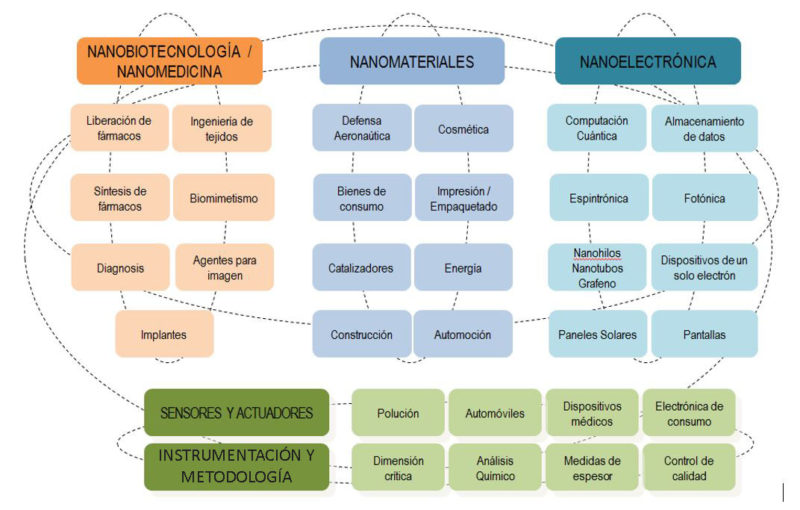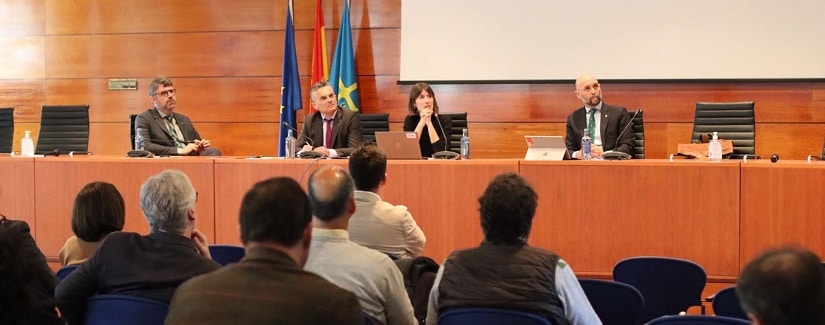The variety of fields of application for nanotechnology give this discipline great potential to transform the economies of countries and change the production processes of their industries. That is why governmental entities and the private sector are getting involved, promoting the creation of research centers, launching R&D programs, and establishing alliances for the development of nanomaterials for multidisciplinary use.
Although exploration into nanotechnology has been studied for decades, awareness in the business world and society is not as widespread. But what is it exactly? Each segment of a millimeter divided into 1 million parts is a nanometer (nm). All objects with a size between 1 and 100 nm are on the nano scale. Having clarified this concept, Dr. Antonio Correia, founder and chairman of the Phantoms Foundation and coordinator of the Spanish Nanotechnology Network (NanoSpain), explains that “nanoscience is based on the study of material on a nanometric scale, while nanotechnology is responsible for developing applications and devices based on the properties of materials at that scale of size.”
The study of those elements at such a small magnitude is justified because their properties vary considerably compared to their qualities at larger scales, so the aim is to understand the behavior of the material at the “nanoscale” and turn that knowledge into new products and applications. “Being able to ‘play’ with material at such small sizes enables us to discover new and infinite properties and possibilities that could be applicable in the future,” says Correia.
Nanotechnology proposes revolutionary solutions in a variety of sectors, redesigning production systems and obtaining new materials and devices.
Impact sectors
The scientific community has spent years researching atoms, molecules, carbon nanotubes, nanoparticles, graphene, nanothreads, deoxyribonucleic acid (DNA) chains, proteins, liposomes, viruses, antibodies, etc. in order to implement them in a large number of industries.
There are currently multiple applications of nanotechnology in different sectors, as Dr. Correia explains:
– Textile: Creation of nanomaterials for use in work equipment, such as fire-resistant, water-resistant, and heat-controlling fabrics.
– Automotive: Development of carbon-based microfibers that are a hundred times stronger than steel for the manufacture of engines; more resistant windows; reinforcement agents in tires; rubber products; anti-rust coatings; or use of carbon fiber in the development of parts to make auto bodies lighter.
– Construction. Nanomaterials can be applied in products such as cement, mortar and concrete, paint, coatings, insulating materials, and glass, helping reduce their weight or improve their functionality (durability, strength, lightness, fire-resistance, heat stability, self-cleaning and/or photocatalytic properties).

– Medicine: Research is ongoing into nanosensors capable of detecting a single cancer cell in blood and flagging it with magnetic nanoparticles so that external detectors are able to determine its location and apply focused therapy. Much more precise and non-invasive blood glucose detection techniques have also been developed, as well as implants, prosthetics, and chip-based drug administration systems.
– Environment: Development of non-polluting materials, energies, and processes, such as nanocatalysts that make chemical reactions cleaner and more efficient; the manufacture of more effective materials in engineering projects; nanosensors to detect hazardous chemicals or toxic gases; or materials that optimize the remediation of contaminated soil, water, and air.
In construction, nanomaterials can be applied to products such as cement, concrete, insulation, paint, and coatings.
– Energy: Perfection of production systems (such as LEDs) and energy storage (nanoporous materials) through the improvement of conductive materials (energy savings); production of photovoltaic cells and their components; nanotubes and particles for use in condensers and batteries; nanomaterials for application in the field of alternative energy production; and conductive materials to generate more efficient thermal insulation.
– Electronics: Creation of electronic components that considerably increase processing speeds in computers; creation of semiconductors; quantum nanowires; graphene-based circuits; and carbon nanotubes.
International Alliances
The potential of this technology is so great that the governments of the most developed nations have promoted investments in this field for the past 20 years, especially in the United States, South Korea, and Japan, which are leading research into nanoscience thanks to the large budgets they allocate to this field.

Dr. Correia highlights Europe’s role in recent years, especially in flagship projects that require a very significant investment (around one trillion euros over 10 years) and have nearly 150 institutions involved from both the academic world and industry. This research has taken the EU to the top of the ranking in some cutting-edge sectors, such as graphene and nanomedicine. In addition, the cooperative European R&D+i intergovernmental initiative Eureka is launching a new project, known as the Eureka Graphene Cluster, to promote companies in that sector.
The EU tops the ranking in some cutting-edge sectors such as graphene and nanomedicine.
Nanotechnology is also one of the European Union’s six essential facilitator technologies, key to its industrial policy. So much so that the Research and Innovation Framework Program (Horizon 2020) expects that in the coming year “nanotechnologies will be fully integrated into our daily lives, providing benefits to consumers in a variety of areas, such as food and health, generating new industrial solutions. They will result in improved productivity, greater efficiency in the use of resources, and lines of sustainable development.”
But public entities are not the only ones showing interest in this discipline. “Companies’ activity in the field of nanotechnology shows the proximity to the market of some of the discoveries that came out of the laboratories a few years ago,” says the Phantoms Foundation chairman. In some leading countries in this field, around three-fourths of the national expenditure in research and development comes from the private sector, which is prone to establishing alliances between companies from different fields of science, reinforcing the combination of their advances and discoveries. However, it is estimated that nanotechnology will generate a global business in excess of two trillion euros in 2020 and that it has created between two and six million jobs since 2015.
That is why the countries that are leading technological research on a global scale (US, Australia, Japan, South Korea, India, China, and Israel) have thrown themselves in to creating research centers and launching international R&D initiatives. Among them there are two in which Spain’s participation is noteworthy: the European Strategy Forum on Research Infrastructures (ESFRI), which plays a key role in formulating policies on research infrastructures; and the International Iberian Nanotechnology Laboratory (INL), which seeks to create solid scientific communities between Spain and Portugal, with special emphasis on Europe, Latin America, and the Mediterranean. Correia also highlights the important role of ICEX with the Spanish Nanotechnology Internationalization Plan, which he coordinated through his foundation for over 10 years.
Industrial Incorporation
Dr. Correia says that “it is obvious that nanotechnology opens the door to new applications through the exchange of ideas that comes with multidisciplinary spaces and the powerful manufacturing and synthesis techniques that are being developed.” All in all, he believes that the arrival of this discipline to factories for massive commercialization requires “a maturing stage that makes it possible to overcome many of the problems that arise when moving up to an industrial scale.” That is why he reiterates that, although many applications are currently being developed, technologies must still evolve that are capable of handling and assembling billions of nano-objects to obtain materials or devices capable of carrying out complex functions.
INDUSTRIAL APPLICATIONS

Source: Phantoms Foundation
In addition, the entire process includes a series of challenges that must be overcome. On the one hand, working with more advanced technology brings with it a great cost that science must overcome by finding financing through different national state agencies. On the other hand, there are legal and ethical aspects related to the use of nanotechnologies in different applications that must be studied by specialized entities in order to regulate their use, which “can delay some developments, but must be done, as it is a new technology.” In this sense, the European Union, as well as the leading nations in R&D+i, have spent years investing in establishing protocols within research and developing measurement and testing instruments to guarantee the safety of these materials without raising unnecessary barriers to their advancement.
As work is done to overcome these challenges, nanotechnology will be incorporated into industries. To do that, Antonio Correia says two types of processes will be used:
– Top-down, which begin with large-scale systems to achieve systems with nanometric parts using grinding, attacking, cutting, polishing, lithographic, pyrolytic, and other techniques.
– Bottom-up, which begin with small units — atoms, molecules or different nanostructures — to assemble complex systems capable of carrying out a variety of functions of increasing complexity. The latter strategy is typical of biology, which is a great source of inspiration for nanotechnology.
In any case, its industrial evolution is noteworthy, as nanotechnology proposes revolutionary solutions in a multitude of sectors by redesigning the production systems and obtaining new materials and devices, while “acting as one of the foundations for the next industrial revolution.”
 Antonio Correia
Antonio Correiahas a PhD in Material Science from the University of Paris, thanks to his research work conducted at the French National Center for Scientific Research (CNRS).
He has worked in France at the CNRS and in Spain at the CSIC, both of which are national research institutions. He is the author or co-author of over 60 scientific articles in international journals and guest editor for several books. He has taken part in 10 European projects since 2004 as coordinator or member of the coordination committee.
He is currently the founder and chairman of the Phantoms Foundation, a non-profit organization created in November 2002 in Madrid, which is a member of the NanoSpain network of 380 research groups and companies (over 4,000 researchers) involved in nanoscience at the national level.




